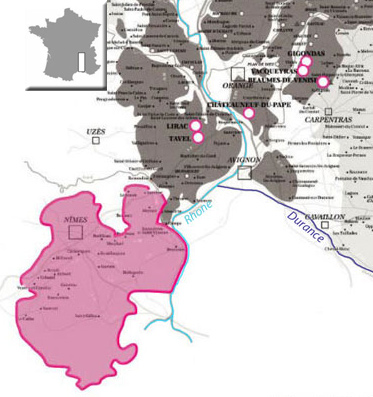I had the pleasure of showing James Molesworth of Wine Spectator around our appellation earlier this month, and in showing him the different terroirs in Costieres it got me thinking that it might be a subject that would interest more than a few wine nerds. So here it goes…
Costières de Nîmes is most southern of the Rhone vineyards. Our plateau and hills stretch 45 km towards the Petit Rhône River and down to the edges of the Camargue. We are a low altitude vineyard.

southern Rhone map
Our Costières is a ridge of the earth’s crust that has been forced upward between two faults raised by the pressure of Tertiary sediments from the bottom of the sea. At the end of this period, the warming temperature caused the glaciers to melt. Bodies of water and ice jams, ancestors of the Rhone and the Durance, carved their way to the sea, destroying and dragging in their path boulders, rocks, gravel and silt.
The journey was long and had a natural sorting: the biggest rocks sank and later littered the landscape, the smallest and most eroded were transported and later deposited in the alluvial fan between the Rhone and the Durance. The rounded stones so typical of Chateauneuf and Costieres are essentially siliceous (sedimentary silica). But they were not the only ones to have been carried by the two rivers. Granite and other limestone were also taken with erosion doing its bit as well. What remains today are polished stones, sometimes attacked on one side by the wind. This deposit took millions of years to accumulate.
We can identify the older rocks (or galets) under layers of loess (silt brought by the wind) from their rough aspect. They are in fact a result of limestone that was percolated by the rains and then solidified onto the rocks’ surface. The younger rocks from the Rhone keep their soft patina.
In contrast, those of the Durance are totally different. They are found south of St Gilles where the Durance mixed with the Rhone. They are called variolites, because of holes and other crevices of the surface (as in smallpox). The photo above shows the terroir in southern Costières. You’ll also notice that the rocks and stones have sharper edges and more uneven weights.
So what difference does any of this make for our vineyards? In northern Costières de Nimes, the surface layer of several meters of large stones stores up the heat of the sun during the day and releases it during the night, as in Chateauneuf du Pape. The result is rich, powerful, round wines.
The smaller, sharper-edged galets of the south create a soil that remains soft. You only have to walk the vineyards here to feel just how much the soil gives under foot. The land here rarely has to be tilled. In addition it has tremendous draining ability, even after the flooding rains that we often get in late fall. The vineyards here give elegant, vibrant and mineral wines.
So although Costières de Nîmes has two very different terroir, they both have a very unique common characteristic. The mass of heat produced by our stones reinforces the effect of convection at night: the fresh sea air that comes in off of the Camargue meets this hot air mass when rolling up the length of the Costières, in this way causing a vacuum of air. The temperate effect of this breeze increases the temperature range between day and night. As a result, a freshness and purity of fruit is preserved in the wines produced from our vineyards.
You can read James Molesworth’s November 11th post from his blog “Stirring the Lees” where he writes about his visit with us and includes a couple videos of Michel. 2011 -blog JM – Wine Spectator
To enter our website, you must be of legal drinking age in your country.